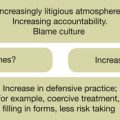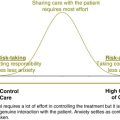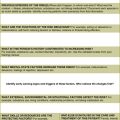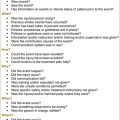Chapter 7 Systemic aspects of risk assessment and management
Risk is never limited to the patient. Clinicians, family, the wider community, other health services and so on will all be involved. At its simplest level, risk will be managed between one individual clinician and the patient but this is an unusual situation. More commonly the potential consequences of an adverse outcome will be felt by a much wider selection of people and they are likely to become involved in some way in the assessment and management of the risk. Family and friends are often vital informants who will help identify early warning signs and triggers for risk behaviours.
Multidisciplinary team (MDT) dynamics affecting risk assessment and management
Group cohesiveness
Within a mental health team, there is likely to be more than one clinician involved in the care of a patient and even if there is only one clinician directly involved, the patient’s care will be discussed in a MDT format. The cohesiveness or otherwise of the staff group can have a large bearing on risk management. Group cohesiveness can break down for several different reasons, such as weak leadership or one clinician holding a grudge against another. Any psychological process affecting an individual clinician can also affect the MDT as a group. As is the case with individual staff, the capacity of the group to think and reflect may be impaired in a setting of risk and perceived danger.1
For example, if the psychiatric registrar is anxious about the care of the patient, this may make other clinicians anxious and the whole team becomes risk-avoidant. This will then need to be managed as a team problem. Conversely, if the MDT is supportive, anxiety will be lower and the risk thermostat for the team will be set differently.
Another influence on group decision-making is the concept of ‘groupthink’.2, 3 Groupthink is a type of thought exhibited by group members who try to minimise conflict and reach consensus without critically testing, analysing and evaluating ideas. Individual creativity, uniqueness and independent thinking are lost in the pursuit of group cohesiveness. During groupthink, members of the group avoid promoting viewpoints outside the comfort zone of consensus thinking. Groupthink may cause groups to make hasty, irrational decisions where individual doubts are set aside for fear of upsetting the group’s balance. Groupthink is more likely to occur in situations in which there is directive leadership, the group perceive themselves as being under stress from external threats or where there are excessive difficulties in the decision-making tasks. Moral dilemmas are also likely to invoke groupthink.
Clinicians perceiving patients as hostile
When some clinicians perceive a patient as being hostile and ‘negative’ and other clinicians perceive the same patient as being helpless and a victim of their circumstances, tension will be set up within the staff group. This is sometimes diagnosed as the patient ‘splitting’, which may be correct; for example, ‘the manipulative patient’, but any tension or conflict within the staff group needs to be recognised as well. The classical scenario is of an inpatient who ‘threatens’ to self-harm on the ward. It is not unusual for some clinicians to feel that the patient is fully in control of their actions and to say that they are just manipulating the situation to get attention, and for other clinicians to say that the patient can’t help their feelings. In these situations, risk assessment can be sabotaged by dissenting clinicians.
It almost goes without saying that the team leader needs to have good skills in risk assessment and management in order to not to have to rely on his/her authority. Being able to model best practice and create a climate in which risk assessment is seen as being core business is vital.4
• Does the team have processes in place to manage group anxiety?
• Does the team make decisions depending on the greatest anxiety of any individual team member or does the team leader have the capacity to manage stress and implement good risk assessment and management processes?
• Is the team caught up in mindless completion of forms rather than being able to explore the risk issues?
• Does form-filling become a defence to protect the anxiety of the team?
In summary, utilising collective judgment is likely to improve the quality of the risk assessment as long as the ‘collective judgment’ is not distorted by pathological processes working within the group.5
See Murphy’s Risk Assessment As Collective Clinical Judgment (2002)6 for a more detailed discussion of this topic.
Exercise 1 — level of risk changing over time
Alison is 45 years old and is suffering from a major depressive disorder with current suicidal intent. She has made one attempt at suicide in the past. Her treatment for previous episodes of depression has included hospitalisation, ECT and prophylactic antidepressants. Her very supportive family is coming to the end of their capacity to cope with her suicidal depression and asks for your help. You want to admit her to
BOX 7.1 SYSTEMIC ASPECTS OF RISK
• Risk is not limited to one person. There are invariably systemic components to it.
• Family are vital informants in the assessment and management of risk.
• The patient, family and MDT should consider the risk.
• Adverse outcomes can be prepared for by the patient, family and MDT.
• Team leaders have a vital role to play in managing both individual staff and team anxiety. Any evidence of secondary risk management should lead to a review of individual, team or wider system functioning.
• The team should not succumb to the greatest anxiety of any one member of the treatment team (e.g. case manager, psychiatrist or team leader).
• As with individual clinicians, the MDT need time to reflect on their actions.
hospital because you feel that her suicidal intent is acute. You know that if you admit her to hospital, she will be taking the last available bed and this is the beginning of the weekend.
As you read this, consider where your risk thermostat is set. What are the factors that have influenced its setting? Identify the systemic components which may affect your risk management. Possible answers to this exercise appear in Appendix 3.
(The management of these issues will be covered in Part 2.)
Other systemic issues which will have a bearing on risk assessment and management include:
• Resources available. Do individual clinicians or the team feel that there are often insufficient resources available to manage certain situations? How is this managed? (See page 116.)
• Health and safety processes; for example, are there alarm buttons in the offices?
• Having a risk management team who give feedback.
• The availability of guidelines. Are these available in printed form at each base?
• Being aware of the increased risk which occurs during shift change in inpatient units is something which all staff should carry in the back of their minds.
BOX 7.2 PRACTICE TIP
• Clinicians can ask for advice from colleagues and senior clinical staff within and outside the team and make use of MDT reviews.
• Case conferences are an excellent way of exploring risk and treatment possibilities.
• Consider requesting a second opinion or a consultation from a specialist service such as the forensic service or the regional personality disorder service or using other expert practitioners.
• The legal services of the mental health service are available for advice in unusual circumstances.
• Refer to the guidelines and other resources listed on pages 4–5.
BOX 7.3 CLINICAL TIP: REQUESTING A SECOND OPINION
• Requesting a second opinion is an excellent way of receiving support, having a fresh set of eyes look over the problem and getting specialist advice.
• Clinicians will get far greater benefit from this resource if they:
1 Murphy D. Risk assessment as collective clinical judgment. Criminal Behaviour and Mental Health. 2002;12:169–178.
2 Janis I.L. Groupthink: Psychological Studies of Policy Decisions and Fiascos. Illinois: Houghton Mifflin Harcourt International Publishers; 1982.
3 Schafer M., Crichlow S. Antecedents of groupthink: a quantitative study. The Journal of Conflict Resolution. 1996;40(3):415–435. Sept






